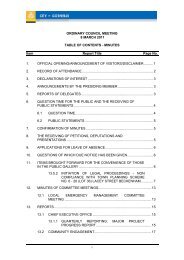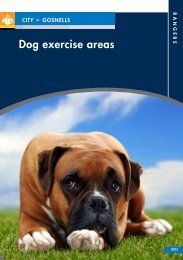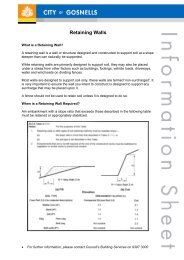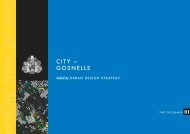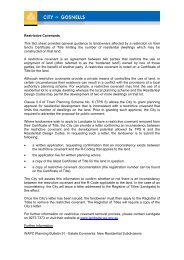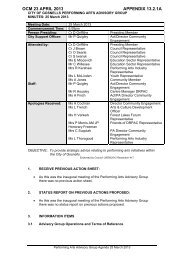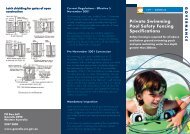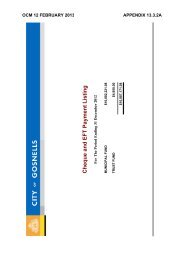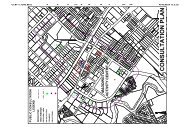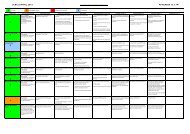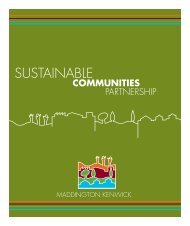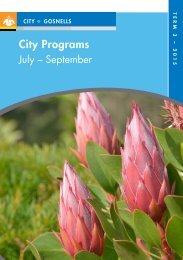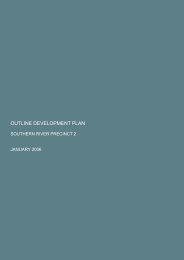Summary - City of Gosnells
Summary - City of Gosnells
Summary - City of Gosnells
Create successful ePaper yourself
Turn your PDF publications into a flip-book with our unique Google optimized e-Paper software.
Vegetation 505. Vegetation5.1 Vegetation Desktop StudyRare and threatened vegetation and other Threatened Ecological Communities (TECs) that are listed as being<strong>of</strong> National Conservation Significance under the EPBC Act are designated as one <strong>of</strong> the six categories(Critically Endangered, Endangered, Vulnerable, Conservation Dependent, Extinct, Extinct in the Wild) asdefined by the Australian Government Department <strong>of</strong> Environment, Water, Heritage and the Arts (DEWHA,2008b). (See Appendix A for definitions <strong>of</strong> the EPBC Act categories relevant to this MKSEA survey.)The Western Australian Department <strong>of</strong> Environment and Conservation also maintains a list <strong>of</strong> ThreatenedEcological Communities (TECs) that have been endorsed by the Western Australian Threatened Species andCommunities Scientific Committee and the Environment Minister <strong>of</strong> Western Australia, but some <strong>of</strong> theseare yet to be endorsed at the Federal level. These TECs are defined under the same criteria and are equivalentto the categories <strong>of</strong> Threatened Ecological Communities under the Federal EPBC Act. The WesternAustralian Department <strong>of</strong> Environment and Conservation also maintains a list <strong>of</strong> Threatened EcologicalCommunities (TECs) that have been endorsed by the Western Australian Threatened Species andCommunities Scientific Committee but are yet to be endorsed by the Environment Minister <strong>of</strong> WesternAustralia. These last TECs are designated as Priority Threatened Ecological Communities (PTECs).5.1.1 Vegetation <strong>of</strong> National Conservation SignificanceA search <strong>of</strong> the Threatened Ecological Communities Database <strong>of</strong> the Australian Government Department <strong>of</strong>Environment, Water, Heritage and the Arts (DEWHA, 2008b) for the local government areas <strong>of</strong> <strong>Gosnells</strong>,Kalamunda and Canning yielded records <strong>of</strong> two TECs listed under the EPBC Act (Table 5.1).Table 5.1: Vegetation <strong>of</strong> National and State Conservation Significance known from the vicinity <strong>of</strong> the MKSEASCPFCT3an/aName <strong>of</strong> TECEucalyptus calophylla – Kingiaaustralis woodlands on heavy soilsShrublands and woodlands onMuchea Limestone(Keighery and Keighery,1995)Occurrences in vicinity <strong>of</strong>MKSEADundas Road, Forrestfield andBrixton St Reserve (BFS 387).Not supplied on EPBC databaseConservation status(WA) Atkins, 2008Critically EndangeredCR B) ii)EndangeredEN B) ii)Conservationstatus (Federal)EPBC ActEndangeredEndangeredFurther searches <strong>of</strong> the literature (including Trudgen and Keighery, 1995 and Government <strong>of</strong> WesternAustralian, 2000) and the TEC database <strong>of</strong> the Western Australian Department <strong>of</strong> Environment andConservation showed that no other occurrences <strong>of</strong> other nationally listed TECs had been recorded inCannington, Forrestfield, Kenwick, Maddington, Orange Grove, Queens Park, Southern River, Welshpool orWattle Grove.The two TECS listed under the EPBC Act in the vicinity <strong>of</strong> the MKSEA are discussed further below.1. Corymbia calophylla – Kingia australis woodlands on heavy soils <strong>of</strong> the Eastern Swan CoastalPlain (SCP FCT 3a)The series <strong>of</strong> Marri (Corymbia calophylla) - dominated plant communities (FCTs 3a, 3b and 3c) that occuron the alluvial soils between Waterloo (near Bunbury) and Bullsbrook are considered to have been the mostextensive vegetation types on the eastern side <strong>of</strong> the Swan Coastal Plain (Beard, 1979a). However, all forms<strong>of</strong> this vegetation unit have undergone extensive clearing and are now rare (Keighery and Trudgen, 1992;Gibson et al. 1994; DEP, 1996). The Corymbia calophylla - Kingia australis vegetation was found to besubject to the most prolonged waterlogging; whilst the other two units inhabited sites where there was betterdrainage. The Corymbia calophylla - Xanthorrhoea preissii unit was associated with the driest conditionsand in Gibson et al. (1994) had the lowest species-richness <strong>of</strong> the three eastern SCP Marri units (48.0 spp.Tauss, C. and Weston, A.S. (2010). The flora, vegetation and wetlands <strong>of</strong> the Maddington-Kenwick Strategic Employment Area.A survey <strong>of</strong> the rural lands in the vicinity <strong>of</strong> the Greater Brixton Street Wetlands. Report to the <strong>City</strong> <strong>of</strong> <strong>Gosnells</strong>, W.A. Version 18.04.10



